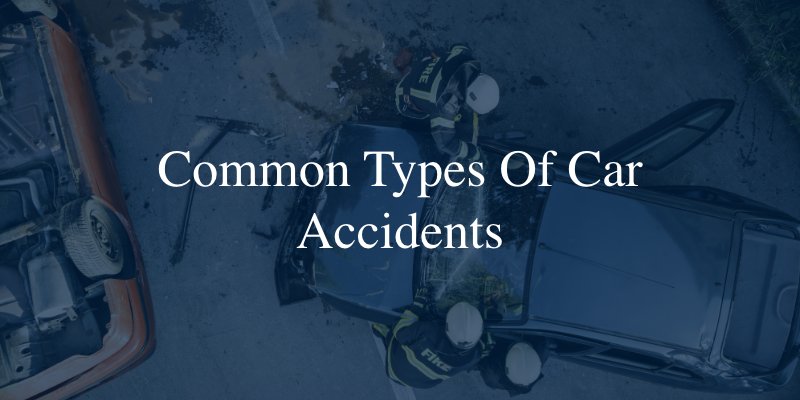Types of Car Accidents
Request a Free ConsultationMost drivers have experienced at least a minor, parking-lot fender bender, but some car accidents are more than irritating and inconvenient. There were 5.2 million hospitalizations and 46,027 deaths from car accidents in the United States in 2022 alone. Drivers have a duty to follow traffic laws, avoid distractions, and take all reasonable measures to prevent causing an accident and harm to others on the road.
When a driver makes a careless mistake or reckless action and the result is an accident with injuries, injury victims have legal options to recover their losses. In no-fault insurance states like New Jersey, drivers may file claims against their personal injury liability policies or, in some cases, hold an at-fault driver financially accountable with a lawsuit. The amount of compensation an accident victim recovers depends on the property damage and the severity of the injuries. Often, the type of car accident as well as the speed at which the accident occurs determines the value of a car accident claim.

Single-Car Accidents
We usually think of accidents as involving two drivers, but about half of all car accidents are single-vehicle accidents. Single-vehicle accidents are those with injuries and property damage only to one car. Examples of single-car accidents are those caused by tire blowouts or a speeding driver who loses control. Common types of single-car accidents include:
- Roadway departures
- Collisions with obstacles
- Rollover accidents from loss of control due to road hazards or animals on the road
Some single-car accidents result from another driver’s actions, even if only one car crashes. For instance, if one driver drifts from their lane, another driver may swerve to avoid an accident and then lose control, resulting in a crash with an obstacle or a roadway departure accident.
Two-Car Accidents
Two-car accidents are common in New Jersey and elsewhere. Two-car collisions often cause serious injuries to occupants in both vehicles. Crash force increases when both cars are moving at full speed when the collision occurs. Below are common types of two-car accidents that our injury lawyers in South Jersey specialize in.
Side-Impact Collisions
Side-impact collisions are sometimes called T-bone accidents, angle collisions, or broadside accidents. They make up 44.9% of all two-car collisions. Side impact collisions usually occur in intersections or when one vehicle exits a parking lot or driveway onto a roadway. In a side-impact collision, the front end of one vehicle collides with the side panel or door of a second vehicle, forming a T-shape. Although occupants of both vehicles may suffer serious injuries, motorists in the vehicle hit on the side face a higher risk of serious injuries because the side of a car is the thinnest point, lacking the buffer of the engine in the front end of the vehicle and the trunk in the back. Side-impact collisions pose a greater risk to backseat passengers than other types of collisions.
Proving fault in a side-impact accident requires an investigation. It may seem that the driver who hits the side of another vehicle is automatically at fault, but it isn’t always so. Sometimes, that driver has the right of way and another driver fails to yield.
Rear-end Collisions
Rear-end collisions make up 17.3% of all two-car collisions. In rear-end collisions, the front end of one vehicle collides with the rear of a car directly in front of it. Common causes of rear-end collisions are distracted driving, speeding, slippery road conditions, or poor visibility. Rear-end collisions cause serious injuries, particularly to the occupants of the front vehicle who may not see the collision coming and don’t brace for the accident. Whiplash is a common injury in rear-end collisions.
Liability in rear-end collisions typically lies with the rear driver. Only in cases of a front driver’s brake lights or tail lights failing, or a front driver who brakes very suddenly can they be at fault for the accident.
Head-on Collisions
Head-on collisions are terrifying and destructive accidents that occur when two vehicles collide from front end to front end. About 29.6% of two-car collisions are head-on collisions. Injuries in both vehicles are often severe in head-on collisions due to the doubling of the crash force. If both vehicles are traveling at 50 miles per hour and collide head-on, the crash force is the same as a single car colliding with a wall at 100 miles per hour.
Head-on collisions occur when a driver departs from their lane and moves or drifts into a lane of oncoming traffic. This sometimes occurs due to speeding around a corner, improper passing, or distracted driving. Head-on collisions sometimes arise from a car entering a one-way street or a divided highway in the wrong direction.
Sideswipe Accidents
In a sideswipe collision, one car strikes a glancing blow off the side of another vehicle. Depending on the speed at which the sideswipe occurs, injuries could be minor or severe. Severe injuries from a sideswipe often occur as a result of one driver losing control of their vehicle due to the sideswipe.
Sideswipe accidents often occur due to unsafe lane changes or improper merging. When a sideswipe accident occurs, the driver who made the improper merge or unsafe lane change is at fault for the accident.
Multi-Car Pileups
When an accident happens on a roadway where other drivers are moving along at high speeds, other drivers may be unable to stop in time to avoid colliding with the disabled vehicles that have already crashed. This results in multi-car accidents or pileups. These are deadly accidents, often with multiple injuries.
What Causes Most Types of Accidents?
Some accidents result from defective car parts, hazardous road conditions, or inclement weather, but most accidents happen due to driver negligence. Common causes of single or multi-vehicle accidents include the following:
- Distracted driving
- Speeding
- Aggressive driving
- Failure to yield the right of way
- Unsafe lane changes
- Drowsy driving
- Intoxicated driving
Car accidents are a major cause of accidental injuries and fatalities in the United States, including the leading cause of traumatic brain injuries.
Call a Car Accident Attorney From Grungo Law
An accident often requires an investigation to determine who is at fault. Even in no-fault car accident states, determining which driver or other entity—like the manufacturer of a defective car part or negligent road maintenance agency—is at fault is important to the success of an accident claim.
If you’ve been injured in a car accident or a loved one suffered injuries or wrongful death due to another driver’s actions, contact the experienced South Jersey car accident lawyers at Grungo Law today for legal counsel and skilled representation in your claim to recover damages like medical expenses, lost wages, and compensation for pain and suffering.
